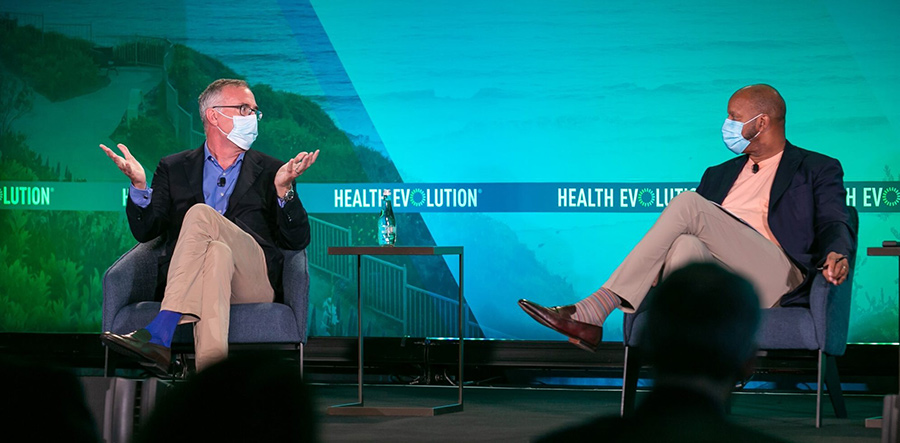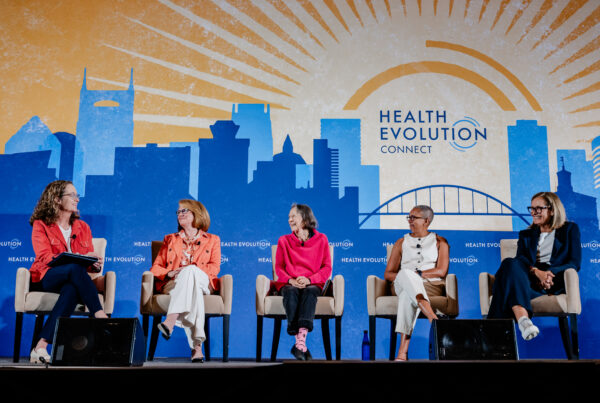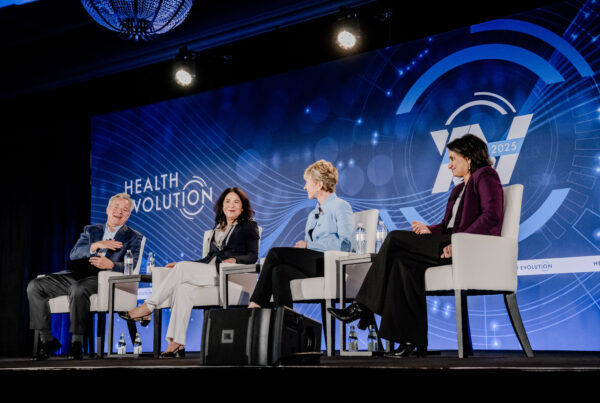When Henry Ford Health System became the first in Michigan to institute a vaccine mandate, President & CEO Wright Lassiter, III, encountered people who thought he was being financially incentivized by big pharma to essentially subject employees to something they did not believe in, trust or necessarily even want.
“A lot of people thought that was a good move we made, and then we had a number of folks who didn’t. I was surprised to get letters from outside the organization, not team members, who told me that they were sure I was being paid by pharma and that I should go search out my soul to cleanse myself of my relationship with pharma so that I do the right thing by our employees,” Lassiter said.
Henry Ford is among the health systems that mandated vaccines prior to U.S. President Joe Biden requiring that all companies with more than 100 employees do so. The mandate also included the stipulation that health care workers at organizations that accept revenue from Medicare and Medicaid must be vaccinated and cannot opt instead for regular testing.
Kaiser Permanente also led the way, announcing in early August that their more than 216,000 employees and 23,000 physicians must be vaccinated by September 30, they then extended that requirement to their supplies and vendors who visit the Kaiser Permanente facilities. In addition to Henry Ford and Kaiser Permanente, ChristianaCare made its move in July and Thomas Jefferson University and Jefferson Health undertook a vaccine mandate as well.
“As health care leaders, I think we must do everything we can to stop the spread of COVID-19 among employees, members and within our communities, including mandating vaccination,” said Greg A. Adams, Chairman and CEO, Kaiser Permanente. “By reducing the gap of vaccinated and unvaccinated we can hopefully eliminate the opportunity for the virus to spread and mutate into stronger, more dangerous variants.”
The health care CEOs who have thus far held off on requiring the workforce to be vaccinated have cited a couple of reasons for not doing so. Some are saying state laws prevent them from enacting these mandates. Others are concerned about the threat that employees may leave in response, which would starkly worsen existing labor shortages.
Several CEOs leading organizations that have mandated vaccines along with public health experts shared early lessons learned at the Health Evolution Summit in late August, including:
-
- Anticipate varying degrees of resistance in the workforce
- Exercise ‘radical communication’
- Establish trust by engaging the community
- Apply protocols to create COVID safe zones
- Advocate that CEOs in other industries mandate vaccines and safety protocols
“The most important thing I do is keep people safe and we keep our caregivers and our employees safe,” said Janice Nevin, MD, President & CEO, ChristianaCare. “That has become increasingly challenging as we’ve seen over the last year and a half.”
Anticipate varying degrees of resistance in the workforce
Steven K. Klasko, MD, President of Thomas Jefferson University and CEO of Jefferson Health, said that much like Lassiter, people questioned which side he was on at first. “But when we got the physicians, and the African American and Latino pastors, and others to say this is important, that made a big difference,” Klasko added.
While ChristianaCare managed what Nevin described as “a vocal minority” outspoken against the vaccine mandate, several other organizations are encountering lawsuits from employees. That said, the first ruling on a similar suit, filed against Houston Methodist, was dismissed by a federal judge in June on the grounds that anyone who does not agree with the policy is free to leave the organization and, thus, not technically forced to receive the vaccine.
Andy Slavitt, former Senior Advisor to the Biden Administration’s COVID Response and former Acting Administrator of the Centers for Medicare and Medicaid Services, explained that messaging to inform people that they cannot come back to work, or school for that matter, unless they prove vaccination, a negative test result or some combination, will work on a sizable number of individuals.
“There are 25 million Americans who say, ‘If I get asked to do it, I’ll do it, but I’m probably not going to do it on my own,’” Slavitt said. “And many are actually perfectly fine with that.”
Exercise ‘radical communication’
Reaching the unvaccinated has been problematic since the pandemic’s outset. Klasko recounted: “When people asked me what the most important part of running 14 hospitals during this pandemic was, it’s radical communication.”
Managing public perception and communicating appropriately are always challenging, during a pandemic and otherwise.
“Communication itself is often your only and best medicine. How well you communicate to the public, how well you prepare the public for changes, those should be treated as more of a science,” Slavitt said. “There’s a general truism, though, which is that when cases are going down, people think you’re doing a brilliant job and when cases are going up, people think you’re doing an awful job. It’s a little like the stock market.”
Klasko added that the team motivated students at Thomas Jefferson University and Jefferson Health by communicating that once 90 percent of them were vaccinated, they could safely return to some of the activities they enjoyed. “Sure enough, our students banded together and did that,” Klasko added.
Adams urged other CEOs and leaders to continue or engage in high-level discussions about work that needs to be advanced throughout the nation.
“From a health systems perspective, from a state and county perspective, we have a new normal and we’re just beginning to grapple with what it means to us and our frontline staff,” Adams said. “The Delta variant of COVID-19 is filling up intensive care units with not just the vulnerable, but now the young, the previously healthy, and most concerning our children. The additional surge of COVID-19 patients puts an incredible strain on our already wearied doctors, nurses, and front-line workers and is overwhelming health care systems trying to provide care to non-COVID patients who delayed care throughout the pandemic. Vaccination is the maximum protection we can provide our workforce, patients, members, and our communities.”
Establish trust by engaging the community
CEOs and leadership teams should also be communicating outside the organization. Adams recounted being in a panel discussion and explaining Kaiser Permanente’s rich history in advancing equity and another speaker indirectly called him out by saying that what organizations have done in the past simply is not good enough – it’s even more important what they are doing right now and into the future.
“The reason we took the time to really examine and listen was because we can’t rest on our laurels. A big part of building trust is engaging and listening and building the relationships that allow communities to see us and to see us own our inadequacies,” Adams said. “None of us are perfect. We’re all on a journey and we’re going to make mistakes. Our society is changing and so our ability to continue to change and evolve is based on our understanding of how we can meet the needs of the communities we serve.”
Adams continued that advancing equity is also about action because communities are not as forgiving as they might have been in the past. And establishing trust is going to take some time despite the public cries for, and stated commitments to, immediacy. Perhaps the strongest communication CEOs and institutions can express is that leaders understand and embrace systemic problems.
“I’ve had conversations with various CEOs across the country and many are finally owning and understanding the changes that need to be made. I‘m seeing corporate America in a process of learning and owning this is real. We need to go through that door together, as straight white men, as gay and lesbian, as Latinx. We need to continue to educate ourselves and look honestly at our systems, and we need to know we’re doing this for everyone,” Adams said.
Henry Ford’s Lassiter added that because trust in institutions has often been difficult, asking the community for their perspectives and utilizing those to develop strategies for solving problems is more effective than creating the solution and presenting it to the community.
Echoing that sentiment, for instance, Pat Geraghty, President & CEO of GuideWell & Florida Blue, said that as recently as a few years ago, many leaders would have taken that approach of creating the solution in-house before serving it to the community.
“One of the best lessons learned is that now we are unveiling the amount we’re funding for community-based ideas so those come forward,” Geraghty explained, adding that the organization also makes it clear that they won’t enter a community and force-fit a solution. It’s a collaborative approach with community partners to ensure the solution meets that community’s unique and diverse needs.
Apply protocols to create safe zones
Until this pandemic is over, the basic need to make work environments safe is as applicable to the organizations mandating vaccines as it is to enterprises that are exempt from doing so, whether because they have fewer than 100 employees or for other reasons.
Slavitt, along with Mark McClellan, MD, Director, Duke-Margolis Center for Health Policy, and a former FDA Commissioner, and former Administrator of the Centers for Medicare & Medicaid Services, John Bridgeland, Co-Founder & CEO, COVID Collaborative and former Director, White House Domestic Policy Council and Steven Phillips, Vice President of Science and Strategy, COVID Collaborative and former Medical Director, Global Projects, Exxon Mobil Corporation spearheaded the COVIDSafeZones initiative to address large and small employers, sports teams and universities with the aim of enlisting them to enact safety protocols across the communities. (Disclosure: Health Evolution Executive Chairman David Brailer, MD, is a signatory on the COVID Collaborative letter calling on private sector CEOs to establish COVIDSafeZones.)
“We’re basically saying there is a way for you to make where you live, work and operate safer. The principal way you can do that is to require vaccinations, but at the very least you should make sure that people have a negative test when they arrive in your environment,” Slavitt said.
If a vaccine requirement is not an option, the COVID Collaborative recommends four tactics for building safe environments:
-
- Infection screening protocol. The public health experts recommend that business leaders institute twice-weekly rapid testing for all employees and regular visitors, though they made a note that this need not apply to retail customers.
- Proof of vaccination. This recommendation highlights that employers should track the vaccination status of their employees and require proof of vaccination where possible to help inform office safety policies. This information, coupled with data on community transmission and case rates, is critical to determining the right safety protocols to enable workplace wellness.
- Incentives for vaccination. This temporary measure involves two steps. The first is to incent employees to receive the vaccine, whether with money, paid time off or other means. A second critical aspect is to make it as easy as possible for people to access the vaccine.
-
- Mask use. Follow up-to-date guidance from the Centers for Disease Prevention and Control, which at the time the letter was written recommended that masks or face coverings be worn by vaccinated and unvaccinated individuals when in public indoor areas in substantial or high prevalence zones.
Advocate that other CEOs institute vaccine mandates and safety protocols
CEOs in health care are uniquely positioned to influence their peers, colleagues and communities. Northwell Health CEO Michael Dowling, for example, has called on leaders to extend their influence outside the organizations they lead to address issues ranging from climate change to gun violence as a public health crises. CEOs can also play an important role, because of their expertise implementing safety protocols, in making the education system safer as Health Evolution advocated last year.
The matter of influence, naturally, is more important than ever in the pandemic.
During 2020, Kaiser Permanente partnered with 3,000 organizations to determine how to engage and educate communities and how to create a sense of ownership so it’s not just Kaiser Permanente bringing vaccines into the community but the community itself bringing vaccines in.
“We are doing everything we can,” Adams said. “We have sports partnerships, we have community health partners, church-based organizations, we have vendors and suppliers. We’re engaged with all of those and saying, ‘We want to talk to you, we want to help you on this journey and to move toward mandating vaccines.’”
Since 2020, Kaiser Permanente has partnered with 3,000 organizations to reach historically marginalized communities, address health disparities, and work toward health equity. The company has also leveraged these partnerships to raise awareness and availability of vaccines.
“We’re calling on other organizations, big and small, to mandate the vaccine for their employees, customers, members, constituents, and other stakeholders,” Adams said. “We’ve also developed a Workforce Vaccine Policy Toolkit as a resource to help organizations implement a vaccine requirement from developing a policy to building vaccine confidence among employees and addressing possible exceptions.”
Ahead of the curve, GuideWell & Florida Blue, which owns or co-owns some 100 different primary care offices, in conjunction with 157 CEOs in multiple industries, wrote a letter taking the position that it is time to focus on mask wearing, social distancing, hand washing and vocalizing their support of the vaccines.
“We were part of organizing that, but you can’t do it alone. It really has to be a coalition,” Geraghty said. “Leading that across all different sectors was important for establishing credibility around those particular topics.”
What’s next: Increasing vaccine uptake to improve workforce resilience
At this point in the pandemic, essentially three groups of Americans exist: The vaccinated, those who have not been vaccinated and people who for some reason cannot become protected.
“It’s because of that third group that you say to the second group, “Look, if you’re going to come into contact with other people, please make sure you’re not spreading the illness,” Slavitt said. “We have an obligation to them. It’s 20 percent of the population that is in that category and we need to focus on them too.”
In the move to vaccinate enough people that the economy can be fully reopened safely, and even despite the financial challenges of 2020-2021, Henry Ford’s Lassiter said that his biggest concerns are not the organization’s financial performance, the challenging resilience around the ways COVID has impacted finances or the potential for market forces to drive significant changes.
“Right now, my greatest focus is workforce,” Lassiter said. “The fact that we’ve lost resilience, we have a workforce that’s beleaguered, we have folks who are deciding because of, or motivated by, the last 19 months that maybe life would be better doing something else or maybe doing nothing.”
Nevin noted that every CEO is concerned about the workforce. After instituting the vaccine mandate at ChristianaCare, in fact, she read every single comment and every email she received from employees.
“The responses that I got for the most part were, ‘Thank you, thank you for keeping us safe’. The vast majority of people are still engaged,” Nevin said. “That’s something that we really have to really focus on. It’s important that we don’t forget that we need to not only work with people who are really having a difficult time and are upset about the mandates and the mask, but we also have to focus on people in the workforce who are engaged and still finding joy and meaning in work.”










